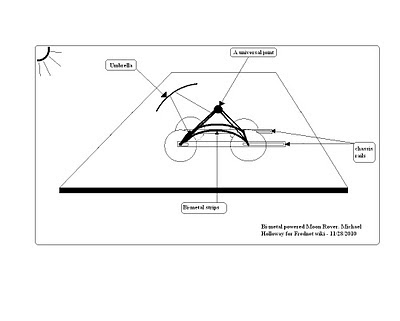Moon Rover powered by a Bi-metal strip 'Thermal Motor'
The "Toaster Engine"
I was thinking about the thermometer type thermal motor (my first Lunar Rover idea, see above) while I was burning some toast this afternoon. I was airing out the room and I was thinking, I need a new toaster. While considering these newfangled $100.00 toasters that use a chip and some fancy censors to pop-up your toast when it's ready - it hit me: why not use the difference in temperature from sunny to shade on the moon to power a rover using a system of bi-metal strips?
(Bi-metal strip rover drawing 7)
 (I can draw a lot better by hand than I can - so far - with Microsoft Paint (I need a scanner), but I hope this helps see the idea.)
(I can draw a lot better by hand than I can - so far - with Microsoft Paint (I need a scanner), but I hope this helps see the idea.)Previously published drawings
Drawing 6:
http://4.bp.blogspot.com/_iovMGXiNw4M/TPHubO_WAOI/AAAAAAAABwE/qjLCy10Rxis/s1600/Bi-metal+strip+rover+6.bmp
The front axial runs through a short slot in the 'chassis rail', basically fixed but able to pivot for turns. The rear axial extends through a much longer slot in the rail at the rear. All four wheel hubs are connected by rods that connect at the tip of a pyramid, a universal joint, which can articulate on the 'x' axis as well as the 'y'.
This 'inch worm' type drive reaches it's apex (it's shortest length), in the shade of the "umbrella" - which is pre-positioned according to the celestial latitude of the sun before a given journey. The umbrella is articulating with the chassis to block the sun from shining on a series of "expansion strips", that are made of a material that changes length considerably between -100 C at +100 C.
When the vehicle reaches it maximum potential point, it's shortest length (as in the Image), the umbrella has moved off from shading, causing the expansion strips to expand in the intense heat of the sun. With the back wheels now locked - (also via a expansion strip breaking system - which could be as simple as a poker sticking through the spokes of the wheels) - the the front wheels move forward.
As the vehicle reaches it's longest point, or it's position of least potential, the umbrella once again has come back over the expansion strips and the period of gaining potential energy begins (ironically through a cooling down towards the temperature of 'empty' space - 4 Kelvin).
[Makes one wonder if this motor is in fact a dark matter engine. :)]
Steering
To change direction, the bi-metal strips on the side one wishes to go are kept in shade (perhaps a shading device flips into place on the previous cycle) thus the wheels on the far side get further apart while the inside wheels stay close together and with the breaks 'on' the vehicle turns.
Next
Lots of problems with it that I've seen while writing this concept outline (especially the turning). A prototype could be made with a Maccano Set.
Test: use a heat gun on a cold January day here in Toronto. Need to research the best metal to test here on earth.
Best material for the conditions on the moon?
Find a test chamber that can go from -100 C to +100 C.
mh
No comments:
Post a Comment